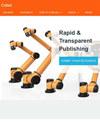Design of robotic hydrogen-filling system for hydrogen-powered vehicles
引用次数: 0
Abstract
Background: The application of hydrogen-powered vehicles is increasingly widespread, however, the hydrogen-filling process can be dangerous, to ensure both safety and efficiency. A new robotic hydrogen-filling system whose consisting of a hybrid robot combined with an automatic guided vehicle and robotic arm is designed. Methods: An analysis of functional composition of the system was performed, and the hardware scheme was designed. A dual-differential drive AGV and an end effector including a holding jaw and a sucker were designed. According to the system workflow, the control system is divided into four modules. A path planning simulation considering obstacle avoidance is carried out based on improved artificial potential field method and a trajectory planning of the operating arm is completed using source code written in MATLAB. Results: The simulation results show that the automatic guided vehicle can avoid obstacles and move to the specified position. The planed trajectory for robotic arm has certain smoothness, which can be proved that the operating arm can complete the process of grasping the hydrogenation gun. Conclusions: The robotic hydrogen-filling system can replace human beings in most of the work of the hydrogen-filling process, which provides a theoretical basis for automatic hydrogen refueling station.氢动力汽车机器人加氢系统设计
背景:氢动力汽车的应用越来越广泛,然而,加氢过程可能是危险的,以确保安全和效率。设计了一种新型机器人加氢系统,该系统由混合动力机器人、自动导引车和机械臂组成。方法:分析系统的功能组成,设计硬件方案。设计了一种双差动驱动AGV和一种末端执行器,该末端执行器包括抓爪和吸盘。根据系统工作流程,将控制系统分为四个模块。基于改进的人工势场法进行了考虑避障的路径规划仿真,并利用MATLAB编写的源代码完成了操作臂的轨迹规划。结果:仿真结果表明,自动制导车辆能够避开障碍物并移动到指定位置。机器人手臂的规划轨迹具有一定的平滑性,证明操作臂能够完成对加氢枪的抓取过程。结论:机器人加氢系统可以代替人类完成加氢过程中的大部分工作,为自动加氢站提供了理论依据。
本文章由计算机程序翻译,如有差异,请以英文原文为准。
求助全文
约1分钟内获得全文
求助全文
来源期刊

Cobot
collaborative robots-
自引率
0.00%
发文量
0
期刊介绍:
Cobot is a rapid multidisciplinary open access publishing platform for research focused on the interdisciplinary field of collaborative robots. The aim of Cobot is to enhance knowledge and share the results of the latest innovative technologies for the technicians, researchers and experts engaged in collaborative robot research. The platform will welcome submissions in all areas of scientific and technical research related to collaborative robots, and all articles will benefit from open peer review.
The scope of Cobot includes, but is not limited to:
● Intelligent robots
● Artificial intelligence
● Human-machine collaboration and integration
● Machine vision
● Intelligent sensing
● Smart materials
● Design, development and testing of collaborative robots
● Software for cobots
● Industrial applications of cobots
● Service applications of cobots
● Medical and health applications of cobots
● Educational applications of cobots
As well as research articles and case studies, Cobot accepts a variety of article types including method articles, study protocols, software tools, systematic reviews, data notes, brief reports, and opinion articles.
 求助内容:
求助内容: 应助结果提醒方式:
应助结果提醒方式:


